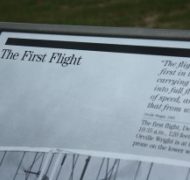Credible
Blog / Produced by The High Calling
If I told you I read a book about Wilbur and Orville Wright and then built a new kind of flying machine, would you believe me? Would you go flying with me? Probably not. Reading a book about the Wright brothers does not qualify me to build a flight craft. I’m a psychologist. A writer. I know nothing about building flying machines. You would probably be very skeptical about my flying machine.
I am not a credible source for building flying machines.
According to Heath and Heath in this week’s chapter of Made to Stick: Why Some Ideas Survive and Others Die, that is an important factor in making our message stick: Credibility.
Antiauthority
There is the obvious kind of credibility—the one it takes to build a flying machine. We put a lot of faith in experts who do that sort of thing. But have you heard of the antiauthority? Would you trust someone who has never studied or been credentialed in a certain area? To demonstrate the effectiveness of the antiauthority, Heath and Heath tell the story of Pam Laffin, the star of a series of antismoking ads in the 1990s. Pam Laffin was a twenty-nine-year-old mother of two who was diagnosed with emphysema at age 24. She underwent numerous painful procedures before dying at age thirty-one. Pam started smoking when she was ten years old. Prior to her death, Pam told her story to the public in brutal TV spots. Cigarette, anyone? According to the Heath brothers, people with personal experiences are a powerful credible source.The takeaway is that it can be the honesty and trustworthiness of our sources, not their status, that allows them to act as authorities. Sometimes antiauthorities are even better than authorities.
It’s All in the Details
Another way to boost credibility is to add details. Research from the University of Michigan indicates that even when the details are not relevant to the decision being made, they influence those making the decision.…vivid details boost credibility. But what should also be added is that we need to make use of truthful, core details…details that symbolize an support our core idea.Like the Liz Lerman Dance Exchange (LLDE). The LLDE describes themselves as a company of dance artists that creates, performs, teaches, and engages people in making art. One of their core values is diversity. While attending an arts and business conference sponsored by two Stanford Business School professors in 2004, the LLDE were taken to task for their claim of diversity. The Heath brothers describe the interaction:
“Come on,” scoffed one of the professors, suspecting an exaggeration. “Everyone claims that they value diversity, but you’re a dance company. You’re probably filled with a bunch of twenty-five-year-old dancers, all of them tall and thin. Some of them are probably people of color, but is that diversity?” Other people in the audience, unfamiliar with the LLDE, nodded at this skeptical response. Peter DiMuro, the artistic director of the LLDE, responded with an example. “As a matter of fact,” he said, “the longest-term member of our company is a seventy-three-year-old man named Thomas Dwyer. He came to the LLDE after a full career working for ht U.S. government when he retired in 1988, and had no previous dance experience. He has now been with the LLDE for seventeen years.” …The professors experienced a rare moment of speechlessness.Thomas Dwyer—the seventy-three-year-old retired government employee—was the face of LLDE’s diversity. Can’t get a more vivid, concrete detail that illustrates the core value of diversity. Pretty credible in my book.





